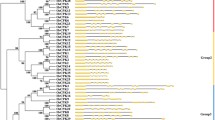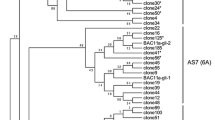Abstract
Legumes, and a very few non-legume plant species, are known to possess functioning haemoglobin genes. We describe here the characterization of a haemoglobin cDNA isolated from barley. The deduced amino acid sequence shows 71% amino acid identity with a non-legume haemoglobin gene, a further 16% of the residues being conservative replacements. The barley cDNA also hybridizes to genomic sequences in rye, maize and wheat. The demonstration of a gene from a monocotyledon with close sequence homology to the known non-legume plant haemoglobins fills a major gap in the known distribution of haemoglobin genes in the plant kingdom. The expression of the gene is induced in isolated barley aleurone layers exposed to anaerobic conditions, and the roots of flooding-stressed barley plants. The expression of the RNA under anoxic conditions is similar to that of a known anaerobic response gene, alcohol dehydrogenase. Our results suggest that the increased expression of haemoglobin RNA is an integral part of the normal anaerobic response in barley. The findings are discussed in the light of current theories of haemoglobin function and evolution.
Similar content being viewed by others
References
Andrews DL, Cobb BG, Johnson JR, Drew MC: The anaerobic response of maize seedlings differs greatly with seedling age. Plant Physiol 101: 407–414 (1993).
Appleby CA: Leghemoglobin and Rhizobium respiration. Annu Rev Plant Physiol 35: 443–478 (1984).
Appleby CA, Bogusz D, Dennis ES, Trinick MJ, Peacock WJ: A role for haemoglobin in all plant roots? Plant Cell Environ 11: 359–367 (1988).
Armstrong W: Aeration in Roots. In: Cherry JH (ed) Environmental Stress in Plants, pp. 197–206. NATO ASI Series vol G19. Springer-Verlag, Berlin/Heidelberg (1989).
Armstrong W, Beckett PM: Internal aeration and development of stelar anoxia in submerged roots: a multishelled mathematical model combining axial diffusion of oxygen in the cortex with radial losses to the stele, the wall layers and the rhizosphere. New Phytol 105: 221–245 (1987).
Arredondo-Peter R, Escamilla E: A concensus sequence of plant haemoglobins. Plant Mol Biol Rep 9: 195–207 (1991).
Bakan DA, Saltman P, Theriault Y, Wright PE. Kinetics and mechanisms of reduction of Cu(II) and Fe(III) complexes by soybean leghemoglobin α. Biochim Biophys Acta 1079: 182–196 (1991).
Bogusz D, Appleby CA, Landsmann J, Dennis ES, Trinick MJ, Peacock WJ: Functioning haemoglobin genes in non-nodulating plants. Nature 331: 178–180 (1988).
Bogusz D, Llewellyn DJ, Craig S, Dennis ES, Appleby CA, Peacock WJ: Nonlegume hemoglobin genes retain organ-specific expression on heterologous transgenic plant. Plant Cell 2: 633–641 (1990).
Brown GG, Lee JS, Brisson N, Verma DP: The evolution of a plant globin gene family. J Mol Evol 21: 19–32 (1984).
Chrispeels MJ, Varner JE: Gibberellic acid-enhanced synthesis and release of α-amylase and ribonuclease by isolated barley aleurone layers. Plant Physiol 42: 398–406 (1967).
Dikshit RP, Dikshit KL, Liu Y, Webster DA: The bacterial hemoglobin from Vitreoscilla can support the aerobic growth of Escherischia coli lacking terminal oxidases. Arch Biochem Biophys 293: 241–245 (1992).
Dishit KL, Webster DA: Cloning, characterisation and expression of the bacterial globin gene from Vitreoscilla in Escherischia coli. Gene 70: 377–386 (1988).
Dixon B, Pohajdak B: Did the ancestral globin gene of plants and animals contain only two introns? Trends Biochem Sci 17: 486–488 (1992).
Fristensky B: Improving the efficiency of dot-matrix similarity searches through the use of an oligomer table. Nucl Acids Res 14: 597–610 (1986).
Fristensky B, Lis J, Wu R: Portable microcomputer software for nucleotide sequence analysis. Nucl Acids Res. 10: 6451–6463 (1982).
Gibson QH, Wittenberg JB, Wittenberg BA, Bogusz D, Appleby C: The kinetics of ligand binding to plant hemoglobins. J Biol Chem 264: 100–107 (1989).
Gilles-Gonzalez MA, Ditta GS, Helinski DR: A haemoprotein with kinase activity encoded by the oxygen sensor of Rhizobium meliloti. Nature 350: 170–172 (1991).
Goldberg M, Dunning SP, Bunn HF: Regulation of the erythropoietin gene: Evidence that the oxygen sensor is a heme protein. Science 242: 1412–1415 (1988).
Good AG, Crosby WL: Induction of alcohol dehydrogenase and lactate dehydrogenase in hypoxically induced barley. Plant Physiol 90: 860–866 (1989).
Gopalakrishnan B, Sonthayanon B, Rahmatullah R, Muthukrishnan R: Barley aleurone layers as a transient expression system. Plant Mol Biol 16: 463–467 (1991).
Hanson AD, Jacobsen JV: Control of lactate dehydrogenase, lactate glycolysis, and α-amylase by O2 deficit in barley aleurone layers. Plant Physiol 75: 566–572 (1984).
Hanson AD, Jacobsen JV, Zwar JA: Induction of alcohol dehydrogenase and lactate dehydrogenase in barley aleurone layers. Plant Physiol 75: 573–581 (1984).
Harberd NP, Edwards KJR: The effect of a mutation causing alcohol deficiency on flooding tolerance in barley. New Phytol 90: 631–644 (1982).
Hirano H: Microsequence analysis of winged bean seed proteins electroblotted from two-dimensional gel. J Prot Chem 8: 115–130 (1989).
Hoffman NE, Bent AF, Hanson AD: Induction of lactate dehydrogenase isozymes by oxygen deficit in barley root tissue. Plant Physiol 82: 658–663 (1986).
Keilin FRS, Wang YL: Haemoglobin in the root nodules of leguminous plants. Nature 155: 227 (1945).
Kennedy RA, Rumpho ME, Fox TC: Anaerobic metabolism in plants. Plant Physiol 100: 1–6 (1992).
Kortt AA, Inglis AS, Fleming AI, Appleby CA: Aminoacid sequence of hemoglobin-I from root-nodules of the non-leguminous Casuarina glauca-Frankia symbiosis. FEBS Lett 231: 341–346 (1988).
Kubo H: Hemoprotein from the root nodules of legumes. Acta Phytochim 11: 195 (1939).
Landsmann J, Dennis E, Higgins TJV, Appleby CA, Kortt A, Peacock WJ: Common evolutionary origin of legume and non-legume plant haemoglobins. Nature 324: 166–168 (1986).
Maniatis T, Fritsch EF, Sambrook J: Molecular Cloning: A Laboratory Manual. Cold Spring Harbor Laboratory, Cold Spring Harbor, NY (1989).
Mohapatra SS, Poole RJ, Dhindsa RS: Changes in protein patterns and translatable messenger RNA populations during cold acclimation of alfalfa. Plant Physiol 84: 1172–1176 (1987).
Murthy PPN: A fast and easy technique for the isolation of aleurone layers. Plant Physiol 90: 388–389 (1989).
Pearson WP, Lipman DJ: Improved tools for biological sequence analysis. Proc Natl Acad Sci USA. 85: 2444–2448 (1988).
Roberts MP, Jafar S, Mullin BC: Leghaemoglobin-like sequences in the DNA of non-leguminous plants. In: Galau GA (ed) Abstracts First International Conference on Plant Molecular Biology p. 14. (University of Georgia, Athens. 1985).
Roberts MP, Jafar S, Mullin BC: Leghaemoglobin like sequences in the DNA of four actinorhizal plants. Plant Mol Biol 5: 333–337 (1985).
Rogers SO, Bendich AJ: Extraction of DNA from plant tissues. In: Gelvin SA, Schilperoort RA (eds), Plant Molecular Biology Manual, pp. A6/1-A6/10. Kluwer Academic Publishers, Dordrecht (1991).
Spiro S, Guest JR: Adaptive responses to oxygen limitation in Escherichia coli. Treds Biochem Sci 16: 310–314 (1991).
Stokes AN: Facilitated diffusion: the elasticity of oxygen supply. J Theor Biol 52: 285–97 (1975).
Thomson CJ, Greenway H: Metabolic evidence for stelar anoxia in maize roots exposed to low O2 concentrations: Plant Physiol 96: 1294–1301 (1991).
Wittenberg JB, Wittenberg BA: Mechanisms of cytoplasmic haemoglobin and myoglobin function. Annu Rev Biophys Biophys Chem 19: 217–241 (1990).
Wittenberg JB, Wittenberg BA, Gibson QH, Trinick MJ, Appleby CA: The kinetics of the reactions of Parasponia andersonii hemoglobin with oxygen, carbon monoxide, and nitric oxide. J Biol Chem 261: 13624–13631 (1986).
Author information
Authors and Affiliations
Rights and permissions
About this article
Cite this article
Taylor, E.R., Nie, X.Z., MacGregor, A.W. et al. A cereal haemoglobin gene is expressed in seed and root tissues under anaerobic conditions. Plant Mol Biol 24, 853–862 (1994). https://doi.org/10.1007/BF00014440
Received:
Accepted:
Issue Date:
DOI: https://doi.org/10.1007/BF00014440




